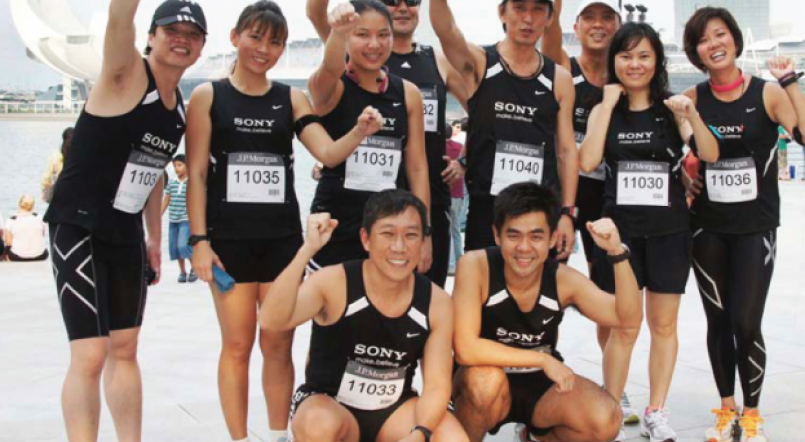HQ Asia: Since 2005, the Sony Electronics Group in Singapore has won five work-life awards, on top of twelve others for the promotion of family life, health and sports. Why is Sony Singapore betting on work-life?

Uemura (fourth from left standing) and Sony staff at JP Morgan Chase Corporate Challenge
Narihiko Uemura: Work-life is our strategy to increase productivity and creativity. Firstly, if our people can manage work and life, their productivity will go up. This may seem counterintuitive, as managers in particular think that work-life initiatives will reduce the employee’s working hours. However, if you think about it, long hours only work in the short run. Over time, productivity actually decreases and at worst, burnout will result.
More importantly, creativity is what Sony is after. On a personal note, when there is something I really want to think about – something related to business – my desk is not the ideal place. I need a free environment so I will go out to a café for a drink or put on my running gear for a run around the neighborhood. That kind of environment stimulates me to be creative. Hence, as part of our work-life initiatives, we recently implemented a free-seating work environment.
We also made our staff lounge a fun place by providing a PlayStation game console and a futsal table, so that employees can relax and interact over a game during breaks. The intention of this is to create spaces for inspiration and creativity.
Long work hours are perceived to be part of the Japanese culture. Given Sony’s Japanese origins, how does this reconcile with Sony Singapore’s focus on work-life?
Sony has always had an open-minded and free culture. This is something that has always appealed to me, even when I first joined Sony in 1981, fresh out from university. Our management showed their views on work-life by living it. For example, our co-founder and first chairman, Akio Morita, started skiing when he was 50 and scuba diving when he was 60. Our next chairman, Norio Ohga, was a professional orchestra conductor and flew aeroplanes. Of course, work is what we have to do. But, in addition, we must also enjoy life.
The Japanese character for “busy” (忙), which is the same as the Chinese equivalent, comprises two parts: 忄meaning the mind, and亡 meaning loss. Hence, ‘busyness’ is the loss of the mind.
What is your personal philosophy on work-life?
Work-life is a state of mind. The Japanese character for “busy” (忙), which is the same as the Chinese equivalent, comprises two parts: 忄meaning the mind, and亡 meaning loss. Hence, ‘busyness’ is the loss of the mind.
The neurotransmitter, serotonin, prevents the human from remembering everything, which means one has less things to worry about. This keeps the mind fresh. Unfortunately, some people are unable to switch off from work - when they go home and watch television, they are still thinking about work issues and cannot relax. On the other hand, if they engage in an activity which they enjoy before going home, such as going for a run or a badminton game with colleagues, they will be able to better relax and this acts as a switch from work to fun.
A work-life initiative is similar to serotonin, or like a switch. If you learn how to switch your mind, you can be refreshed. Choose a switch that suits you, and which ultimately helps you increase your productivity and creativity.
This article was first published in HQ Asia (Print) Issue 04 (2012).


